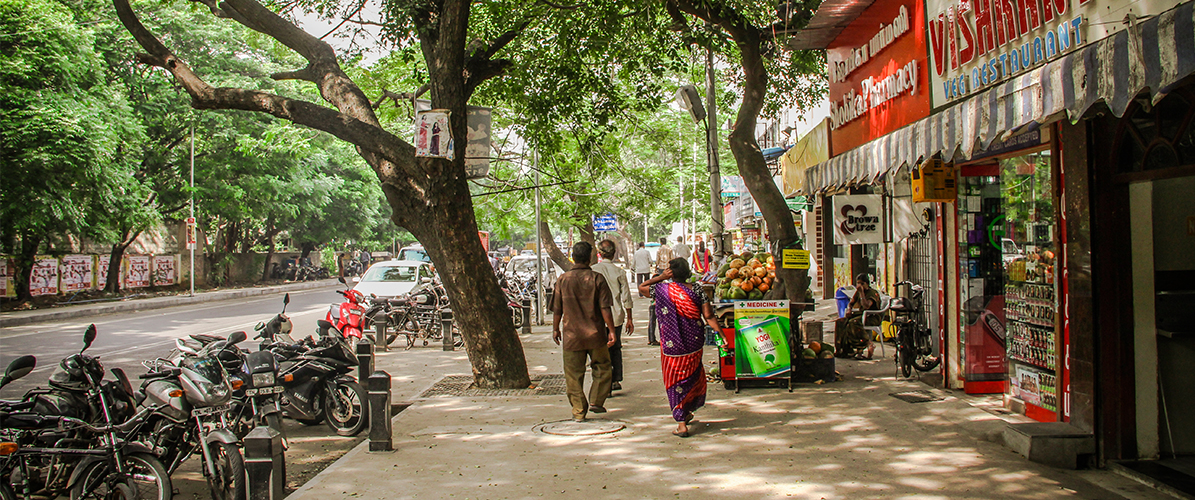By Aswathy Dilip
Chennai is witnessing a transformation. Chennai Corporation is reclaiming precious road space from chaotic traffic, unregulated parking, and haphazardly placed utilities to create wide, continuous, and accessible footpaths—prioritizing people over cars. This radical approach of designing streets is a part of the Corporation’s initiative to promote walking and cycling in the city.
This initiative received a huge fillip earlier this month when Chennai Corporation’s Council adopted a progressive policy that made walking and cycling—or “non-motorised transport,” (NMT) in sustainable transportation jargon—its priority. The policy aims to arrest the current decline in walking and cycling in the city by creating safe and pleasant network of footpaths, cycle tracks, greenways and other NMT facilities. Walking and cycling infrastructure—that until recently was at best an afterthought—will now take centrestage. The policy mandates that a minimum of 60 percent of the Corporation’s transport budget is allocated to construct and maintain NMT infrastructure—a clear demonstration of the Corporation’s commitment to creating safe streets that consider the needs of all users.

Figure 1:Footpaths are either missing or, when present, unusable. With trees, utility boxes and bus stops obstructing movement, pedestrians are forced to walk on the carriageway.
Despite poor pedestrian and cycling infrastructure in the city, over six million trips are made on foot and cycle everyday in Chennai—a third of all trips in the city. Public transport trips—another third of all trips—also start and end on foot (or cycle). As in other cities of India, walking and cycling is an integral part of Chennai’s transport landscape.
With over 10,000 traffic crashes reported every year, Chennai has one of the highest rates of road deaths in the country. Four people are killed on the roads of Chennai every day. Pedestrians and cyclists are highly vulnerable, and the absence of safe walking and cycling facilities worsens the situation.
Recognising the urgent need to transform the scenario, the Corporation has set for itself ambitious goals: by 2018, build safe and continuous footpaths on at least 80% of all streets, increase the share of walking and cycling trips to over 40%, and, most significantly, eliminate pedestrian and cyclist deaths. The Corporation aims to achieve these goals by mandating various measures through this policy.
Pedestrians, cycles and public transport will now take priority over private motor vehicles while designing and managing streets. Street design interventions will be regulated by the Chennai Street Design Manual, a reference manual of street design guidelines that the Corporation mandates to create.
Streets are public spaces—where people meet, shop and travel to destinations. For a long time now, streets are designed primarily to move private vehicles. Bringing the focus back to its varied uses, the policy’s street design principles support and invite multiple uses of the street.

Figure 2: Blank compound walls (right) lining streets contribute negatively to pedestrian realm. The policy lays importance on adopting minimum build-to lines with transparent frontages, frequent entrances, doors and windows, and few blank walls to create a safe and lively public realm, as observed in Pondy Bazaar (left), a traditional shopping area in Chennai.
Traditionally, streets in Chennai buzzed with activity as residential and commercial activities opened directly onto the streets supporting street life. Today, blank compound walls line most streets creating a dull and unsafe pedestrian realm. To recreate safe and vibrant streets, the Corporation calls on concerned agencies to adopt building control regulations which ensure that private developments contribute positively to the public realm.
Highlighting the importance of street management, the Corporation identifies various areas that need immediate attention. These include managing intersections with priority for pedestrians and cyclists, strictly prohibiting encroachments on footpaths, managing and regulating street vending as it improves safety and adds life to the streets, as well as implementing and maintaining street furniture, and managing service utility providers to ensure continuous pedestrian realm.

Figure 3: In contrast to the old footpath on Police Commissioner Street which was narrow, with utility boxes obstructing pedestrian activity; the new footpath (right) is wide with utility boxes moved to provide a continuous pedestrian realm that is accessible to all.
Actual change at street level depends greatly on the rigorous implementation of this policy. The Corporation has already begun several important initiatives, including the implementation of high quality footpaths on all arterial streets as well as the implementation of pedestrian zones in certain quarters. Additionally, in collaboration with Anna University and ITDP, the Corporation has initiated technical training and outreach programmes for its engineers on NMT user needs, design principles, planning, and implementation.
With its bold move of adopting the NMT policy, Chennai has set a high benchmark for all other Indian cities and is leaping ahead in its vision to improve the quality of urban life for all its citizens, regardless of gender, class, and physical ability.
Download the NMT policy here.










